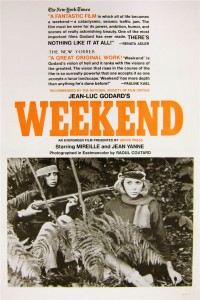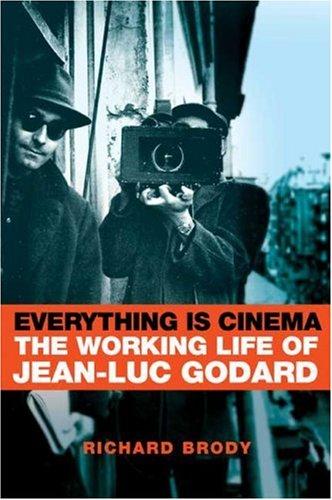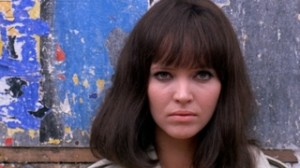

Colin MacCabe, Godard: A Portrait of the Artist at Seventy (Farrar, Strauss, and Giroux 2004)
Richard Brody, Everything Is Cinema: The Working Life of Jean-Luc Godard (Metropolitan Books 2008)
Two biographers have written substantial books on filmmaker Jean-Luc Godard. Despite a common focus on the same biographical subject, and a shared belief that Godard is one of the most important filmmakers of his time or maybe ever, the two writers take markedly different approaches with equally different levels of success.
Godard, of course, was a Swiss-French filmmaker who transitioned from a circle of post World War II cinephiles to a leading director in the French nouvelle vague [new wave] movement in the late 1950s. His cinematic style was revolutionary. His ideas about the nature of cinema were inscribed into his works. He broke all the rules of cinema, from editing to framing, in a kind of ongoing scientific analysis of the form itself that restated classic cinema with streaks of modernism. Like many of his nouvelle vague compatriots he worked largely with low budgets, to preserve a degree of artistic freedom from producers. He shot mostly on location and with scripts often devised during shooting. After a series of critically lauded films through the mid-1960s, many starring his first wife Anna Karina and filmed by cameraman Raoul Coutard, Godard entered a militant period in which he rejected commercial cinema. He made collaborative films with French Maoists, then turned to television and video projects in the mid 1970s. He “returned” to commercial film in the late 1970s, and has remained a critically lauded outsider as he became an octogenarian. His audiences had dwindled. Yet he continued to provoke and expand the possibilities of his chosen medium with new projects. Among his notable later works was a massive and sui generis video project on the history of cinema and the history of the 20th Century released in the late 1990s. An irascible and sometimes misunderstood person, the recent biographies offer impossibly different accounts of the man behind the films. Only one ultimately proves reliable though.
MacCabe brings a comprehensive classical education to bear on Godard’s work. He places Godard in a deep fabric of artistic and political endeavors stretching back centuries. Most fundamentally he provides an explicit analysis of the ideologies Godard adopted in his work, and relates them to his influences and the times and places in which he lived. Personal details are provided only to an extent minimally necessary for an understanding of Godard’s attitudes and ideals. Though perhaps a few possibly unflattering details are omitted. MacCabe also proves an eloquent writer. Take his statement on the motivations of directors like the young Godard:
“It is a truth universally acknowledged that the history of the cinema is the history of a plot by shy unprepossessing and sex-obsessed men to surround themselves with heartrendingly beautiful women.” (p. 123)
MacCabe elucidates the way Godard the film critic established the framework of his cinematic vision, one that is fundamentally an analysis of the nature of cinema. He highlights Godard’s writing while at the journal Cahiers du Cinema that, in hindsight, posits the truth of Godard’s personality (TiNe) and worldview (gauchiste). Discussing one such article, MacCabe probe’s Godard’s conception of cinema in relation to reality:
“What Godard emphasizes — a point that [André] Bazin makes in his almost exactly contemporaneous article on Stalin — is that the cinema is not just a representation of reality, but becomes part of the reality itself.” (p. 72)
This point tends to attract people like Godard. It is a restatement of a point elaborated at length by Alfred Korzybski, who formulated the issue thusly:
“The map is not the territory; the map doesn’t cover all of the territory; and the map is self-reflexive (it becomes part of the territory).” Science and Sanity (1933)
Portions of the book on Godard’s formative experiences establishing new grounds for film criticism with staff of the journal Cahiers du Cinema and his engagement with Henri Langlois’s famous contextual juxtapositions through screenings by the film archive Cinémathèque Française simply crackle with energy. One feels Godard’s excitement. But this reveals also the concepts that his cohorts imparted to him and his work. Crucial is a new view of authorship in cinema, which separated Godard not only from other filmmakers and critics but also made a unique contribution by cinema to the arts as a whole. In it, the audience’s perspective steps forward.
“One locates one’s author not by ignoring the specificity of his artistic medium, but by emphasizing it. . . . Cahiers’s author theory is the only theory of the author which is formulated from the point of view of the audience, and indeed explicitly formulated as a method to move from the position of the audience to that of the artist.” (p. 75)
This concept returns later in the book, transitioning to the legal and political sphere where audience rights are not recognized.
“Godard precisely understands copyright as a crucial artistic and political issue. Most legal discussions turn around differences between the French and the Anglo-Saxon systems, with the French being held to favour the author, while the Anglo-Saxon favours the owner of the copyright. What differences there are pale into insignificance beside the fact that neither system allows the audience any rights whatsoever.” (p. 301)
Brody, writing with MacCabe’s book already published, focuses on factual detail. While Brody did interview Godard (* read on), most of the contents of Everything Is Cinema come from archival research and a few new interviews, mostly of those who lived and worked around Godard. His book therefore functions most effectively in cataloging existing materials on Godard, organized chronologically around Godard’s various professional projects. There are chapters addressing each of Godard’s films. Readers can locate relevant sections in relation to particular works, as they are viewed, and review the citations to find relevant materials. This is quite unlike MacCabe’s approach, which unabashedly favors certain films with longer, more in-depth treatments, and mentions others only in passing. Footnotes are minimal. Another thing that Brody does is draw out (and embellish?) the more lurid details of Godard’s personal life, which MacCabe largely passes over. There is something of a prudish tabloid quality to Brody’s treatment that MacCabe explicitly tried to avoid. And Brody’s tone is like much other writing in The New Yorker magazine (where he is a film critic and editor), burdened with the same arrogant, self-satisfied, self-important conservatism masquerading as mildly left-of-center liberalism that is taken entirely for granted.
Brody’s presentation tries to extrapolate the larger meaning of Godard’s work from very selective factual detail of Godard’s private life. In this way, Brody attempts to remove Godard’s own perspective from the analysis of Godard’s work. MacCabe, in complete contrast, tends to see Godard’s private life as offering little directly useful information about his professional work (with a few notable exceptions for his pre-professional youth, at a high level, and certain later incidents where his public and private life merge), and instead directly engages the public side of Godard’s work on its own. To the extent that Brody draws conclusions, he draws them from the catalogued facts as filtered through his own ideological position. He seems to make his case by drawing a conclusion first, picking only the facts that support that conclusion, and then drawing a “connection” from that subset of facts to the predetermined conclusions. The reasons he draws his initial conclusions are not probed in any meaningful way. Brody’s approach is overarchingly to try to associate Godard with disfavored groups. Critic Adrian Martin wrote that Brody seems to have an axe to grind, and his research focuses only on supporting certain accusations (namely, alleged anti-semitism and misogyny) but not testing them against potentially contradictory facts (or recognizing a lack of factual support). This is the central basis for the (many) claims by critics that Brody tries to smear Godard.
On the substantive analysis of Godard’s work, many have complained that Brody overextends himself in viewing all of Godard’s work as an expression of autobiographical fiction. A damning review by Bill Crohn dismisses Brody’s biography as “cultural journalism”, and cites a New York Times letter to the editor that castigates Brody’s “ideological simplifications and biographical reductivism”. Crohn also details a host of factual errors and blatant factual distortions, along the lines of Martin’s critique. But the complaint about reductionism is at the heart of the matter. Brody returns endlessly to his thesis that Godard’s films should be viewed as strictly autobiographical:
“King Lear gathers in one film all of Godard’s preoccupations from this period, and does so in an extremely original, albeit elusive, form. It . . . was centered on Godard’s self-mythologizing in and through cinema and his recuperation and redefinition of the grand tradition of art by way of the cinema. As such, King Lear is something of a personal manifesto . . . .” (p. 491-92)
This very much recalls the work of lesser biographers, like Terry Teachout with Pops: A Life of Louis Armstrong (2009), which can be viewed as writing a biography as a book-length argument that jazz trumpeter Louis Armstrong’s anachronistic later recordings like “Hello, Dolly!” are important, or Joseph Dofman’s Thorstein Veblen and His America (1934), which has been, somewhat belatedly, criticized for projecting the biographer’s own insecurities onto his biographical subject by extrapolating from dubiously selected facts from Veblen’s private personal life. No one will doubt that there is an autobiographical element to Godard’s work. Yet Brody’s one-dimensional, reductionist approach takes it as just about the only element that matters. It seems like an excuse to justify Brody’s own taste amongst Godard’s works — a bit like Teachout with Armstrong, he seems to want to build up a reason why his personal favorite works are “really” Godard at his best. Brody is entitled to his opinions, but opinions are like assholes, everyone has one. Brody’s views fizzle on their own. Alongside other views, the self-interested moralizing of Everything Is Cinema becomes much more clear. The claims of anti-semitism are one such area. Brody seems to have a difficult time separating anti-zionism (which is not anti-semitic) from anti-semitism. This is Brody’s failing, not Godard’s (who has explicitly drawn this distinction). People with personalities like Godard love to mock those they consider intellectual inferiors by forcing them to read between the lines with veiled insults. To that end, when Brody visited Godard in Europe to interview him, Godard snubbed him, and sarcastically mocked his poor interviewing skills. Reviewer Bill Crohn went so far as to say that Brody’s mean-spirited and distorted bio may have been framed as revenge against Godard for that incident.
MacCabe instead tries to convey Godard’s ideological position, and to contextualize it, and through that filter restricts the raw volume of historical facts presented. There is never any feeling that more facts would alter MacCabe’s conclusions, because his perspective aligns with the basic course of Godard’s work and career. This is what is most strikingly different in Brody’s account as compared to MacCabe’s. Brody does not engage his own ideology explicitly. In his relentless provision of “facts”, usually relating to the private sphere of his subject, he rarely if ever explains the nature of his own frame of reference. In attempting to adopt a neutral and “objective” journalistic stance, he makes a play to impose his subjective position on the reader through an emphasis on lurid gossip of doubtful reliability. This does not sit well.
MacCabe is prone to sweeping statements to elaborate ideological positions, conflicts, and milestones, in cinema and other arts. For instance, his take on modernism as an element in Godard’s work and a factor that shapes the disposition of Godard and his place within the fabric of the artistic world, provides a unquestionably succinct summary:
“Modernism is most familiarly known as the turning of the focus on to the form and medium of art itself. *** The paradox of modernism is thus that it offers a totally democratic view of art — the determination to turn every aspect of both world and self into matter for art — in forms which require a level of attention and commitment which limits the audience to a mere handful.” (pp. 278-79).
But statements like these are explicit in MacCabe’s writing. And they dazzle and delight with their wit and cutting insight. He presents them in the context of ongoing debates. The reader can agree or disagree, complete with some sense of where to look for contrasting viewpoints.
MacCabe is direct in stating that he is an unabashed Godard partisan. He writes in the first person to explain his favorite films and to recount periodic interactions with Godard. He thinks Godard’s best works are Passion (1982), Le Mépris [Contempt] (1963) and Histoire(s) du cinéma (1998), with a sentimental attachment to Made in U.S.A. (1966). Brody states that he thinks Godard is among the best film directors, but clearly despises the man himself and spends most of his biography dredging up (if not fabricating outright) tabloid “dirt”. He favors King Lear (1987) (having identified it as the very best in his list of the ten greatest films ever, while MacCabe says it fails to integrate some excellent constituent parts) and Eloge de l’amour [In Praise of Love] (2001) (which he rates as the best film of its decade). Notice how MacCabe separates out his own views and sentimental attachments from an independent context of critical significance, while Brody posits that his personal views are what defines critical importance? This is why MacCabe’s writing is superior. In all, Brody’s book may serve as a useful chronological bibliography, but as an overview of Godard’s career it is unreliable and biased. MacCabe has offered a very impressive biography, one that captures Godard’s life and work as well as any might. Skip Brody’s tedious tome (I couldn’t even get through it cover to cover) and seek out MacCabe’s wonderful book. Of course, among other writing on Godard, another crucial reference remains the collection Godard on Godard (1985). Godard started as a film critic, and there is a tremendous amount of the filmmaker’s own writings available that shed much light on his manner of thinking and his cinematic work as such.




